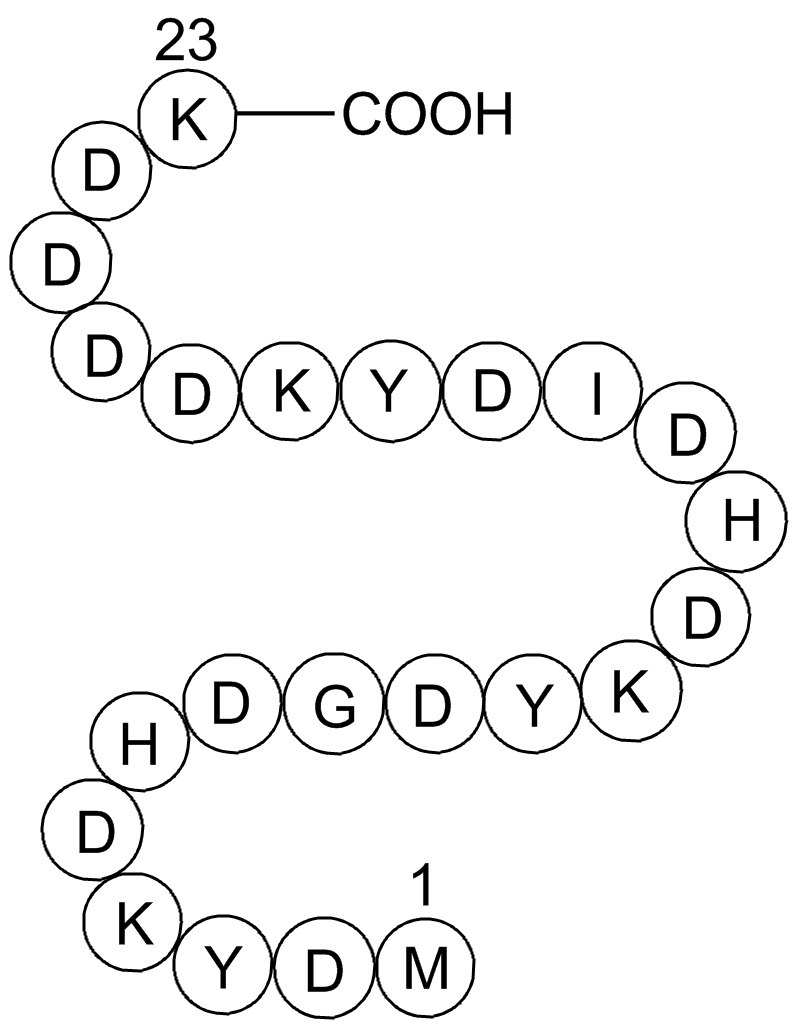3X FLAG Peptide
|
| Catalog No.GP10149 |
Products are for research use only. Not for human use. We do not sell to patients.

Cas No.: 402750-12-3
Sample solution is provided at 25 µL, 10mM.
Le système FLAG-tag utilise un court peptide hydrophile de 8 acides aminés qui est fusionné à la protéine d'intérêt1. Le peptide FLAG se lie à l'anticorps M1. Que la liaison soit dépendante du calcium2 ou indépendante3 reste controversée. Un inconvénient du système est que la matrice de purification des anticorps monoclonaux n'est pas aussi stable que les autres. En général, les petites étiquettes peuvent être détectées avec des anticorps monoclonaux spécifiques.
Pour améliorer la détection de l'étiquette FLAG, le système 3x FLAG a été développé. Cet épitope en tandem de trois drapeaux est hydrophile, long de 22 acides aminés et peut détecter jusqu'à 10 fmol de protéine de fusion exprimée. La protéine liant le maltodextrine marquée avec le tag FLAG provenant de Pyrococcus furiosus a été cristallisée4 et la qualité des cristaux était très similaire à celle des cristaux de protéines non marquées.
Enfin, le tag FLAG peut être retiré par traitement avec l'entérokinase, qui est spécifique pour les cinq acides aminés C-terminaux de la séquence peptidique5.
Références : 1. Hopp TP, Prickett KS, Price VL, Libby RT, March CJ, Ceretti DP, Urdal DL, Conlon PJ (1988) Une courte séquence marqueur de polypeptide utile pour l'identification et la purification des protéines recombinantes. Bio/Technology 6:1204-1210. 2. Hopp TP, Gallis B, Prikett KS (1996) Propriétés de liaison aux métaux d'un anticorps monoclonal dépendant du calcium. Mol Immunol 33:601-608. 3. Einhauer A, Jungbauer A (2000) Cinétique et propriétés thermodynamiques de l'anticorps monoclonal M1 dirigé contre le peptide FLAG. 20ème symposium international sur la séparation des protéines, peptides et polynucléotides (ISPPP). Lublijana, Slovénie du 5 au 8 novembre 2000. 4. Bucher MH., Evdokimov AG., Waugh DS (2002) Effets différentiels des courtes étiquettes d'affinité sur la cristallisation de la protéine liante à maltodextrine Pyrococcus furiosus Biol Cryst 58:392-397. 5. Maroux S., Baratti J., Desnuelle P.(1971) Purification et spécificité de l'entérokinase porcine.J Biol Chem246 :5031-5039 .
Average Rating: 5 (Based on Reviews and 29 reference(s) in Google Scholar.)
GLPBIO products are for RESEARCH USE ONLY. Please make sure your review or question is research based.
Required fields are marked with *





